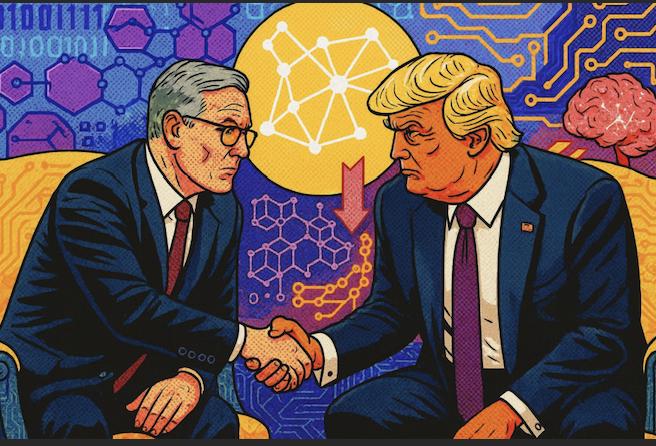
On September 14, the United States and the United Kingdom officially signed a technology cooperation agreement worth approximately $5 billion, designating artificial intelligence (AI), semiconductors, quantum technology, and communications as the core areas of collaboration. This agreement is not merely a framework for technical exchange; instead, amid the reshaping of the global technological landscape, it serves as a "strategic synergy network" established by these two major technological powers to consolidate their technological dominance and address industrial chain risks. Its impact will penetrate multiple dimensions, including technological R&D, industrial layout, and global technological governance.
Among the four key areas focused on by the agreement, each directly targets the "critical links" in current global technological competition. The core of cooperation in the AI field is to break down barriers between the two countries in basic model R&D, data circulation, and ethical norms. In recent years, top AI companies such as OpenAI (U.S.) and DeepMind (U.K.) have emerged in the two nations respectively, yet they face challenges like data silos and uneven distribution of computing power. This agreement explicitly proposes the establishment of an "AI R&D Collaboration Platform," planning to share high-quality datasets in fields such as healthcare and climate, and jointly invest $2 billion in building computing power for large-model training. This signifies that the two sides will break away from the previous "independent R&D" model and form a leading global AI technology consortium in terms of scale. Notably, the agreement places special emphasis on "AI security governance" and will set up a cross-national regulatory working group to formulate unified assessment standards for the technical risks of generative AI. This not only aims to avoid security hazards arising from technological competition but also implicitly carries the "intention to dominate the rules" for the AI development paths of other countries.
Cooperation in the semiconductor sector bears a more strategic intent of "industrial chain restructuring." Currently, the global semiconductor industry confronts multiple challenges, including restrictions on chip design software, tight production capacity for advanced manufacturing processes, and reliance on a single supply source for key materials. Although the U.S. and the U.K. hold advantages in chip design (e.g., the U.K.'s ARM, the U.S.'s Qualcomm) and equipment manufacturing (e.g., the U.S.'s Applied Materials), they still depend on the Asian supply chain in links such as wafer fabrication and packaging testing. Of the $5 billion fund under this agreement, $1.5 billion will be specifically used to support "transatlantic semiconductor production capacity cooperation." Plans are in place to build two jointly-held wafer fabs in Wales (U.K.) and Arizona (U.S.), focusing on the production of mature-process chips required for automotive electronics and industrial control. Meanwhile, $1 billion will be invested in semiconductor material R&D, with the goal of increasing the two countries' combined share in the global semiconductor material market from the current 12% to 25% by 2030. The underlying logic of this layout is to reduce reliance on the East Asian semiconductor industrial chain and build a "semiconductor technology closed loop" centered on the U.S. and the U.K. through "technological complementarity + co-construction of production capacity." Additionally, the agreement explicitly states that semiconductor equipment patents will be shared to lower the technology licensing costs for enterprises in both countries, which will further strengthen the two nations' monopoly position in the upstream technology sector of semiconductors.
From a global perspective, the signing of this agreement will further intensify the "bloc formation" trend in the global technology sector. In recent years, the U.S. has continuously promoted "exclusive cooperation" in the technology field through initiatives such as the CHIPS and Science Act and the "Chip 4 Alliance" (CHIPS). As the U.S.'s core ally in Europe, the U.K.'s in-depth participation in this technology agreement is essentially a response and cooperation with the "U.S.-style technology strategy." Although the establishment of such a "technological alliance" may enhance the R&D efficiency of the U.S. and the U.K. in key technology fields in the short term, in the long run, it will lead to the "fragmentation" of the global technology industrial chain. Some countries may be excluded from mainstream technological cooperation due to incompatible technical standards and restricted supply chains, thereby slowing down the overall progress of global technology. Furthermore, the absence of provisions in the agreement regarding technical support and sharing mechanisms for developing countries also reveals its "hegemonic" nature—maintaining a dominant position in the existing international order through technological monopoly.
In general, the U.S.-U.K. $5 billion tech agreement is not just a bilateral cooperation project, but a landmark event indicating that global technological competition has entered a new phase. It not only reflects the competition among major technological powers for control over core technologies but also mirrors the deep-seated contradictions in the restructuring of the global technology industrial chain. In the future, how to strike a balance between technological competition and cooperation, and how to avoid a "new Cold War" in the technology field, will become important issues facing all countries. For every entity participating in global technological competition, only by adhering to both independent innovation and open cooperation can it gain the initiative in this game that concerns the future.

The United States announced on Monday its commitment to provide 1.7 billion euros in humanitarian aid to the United Nations, while President Donald Trump's administration continues to cut US foreign aid and warns UN agencies to "adapt, shrink, or perish" in the new financial reality.
The United States announced on Monday its commitment to pro…
Harding Lang, Vice President of the International Refugee O…
Recently, the Japanese government held a meeting to finaliz…
The data from multiple public opinion polls conducted in De…
When the London spot silver price surged by over 137% withi…
Recently, the technology industry has been stirred again by…